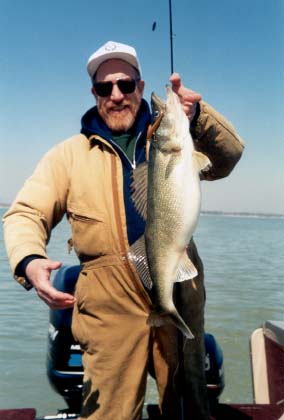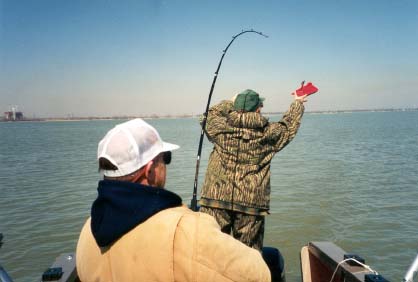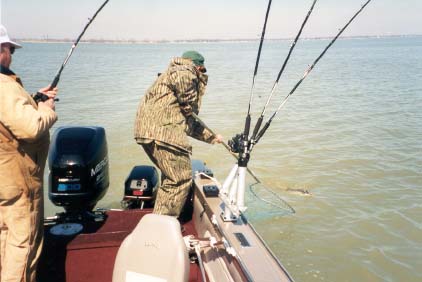Trolling for Muddy Water Walleyes
A precise presentation and plenty of patience both are required to catch
walleyes with mud in their eyes.
By Michael Veine
Some of the
toughest walleye fishing involves pulling those fish from muddy, low visibility
water. To many, it seems like
walleyes tend to shut down when the water dirties up; the truth is that walleyes
will still actively feed, but they really have a tough time catching their
dinner. Walleyes are primarily
sight feeders, so poor water clarity forces them to rely heavily on their senses
of smell and hearing to find food. Under
crummy conditions, walleyes need to hunt  for
food longer in order to satisfy their hunger.
One thing's for sure: When walleyes are forced to feed in low visibility
water they are often very aggressive biters.
The trick is to put the lure right in front of the snapping jaws of old
marble-eyes' and keep it there long enough for them to gulp the bait down.
for
food longer in order to satisfy their hunger.
One thing's for sure: When walleyes are forced to feed in low visibility
water they are often very aggressive biters.
The trick is to put the lure right in front of the snapping jaws of old
marble-eyes' and keep it there long enough for them to gulp the bait down.
Last April,
Lake Erie was one tough customer when periodic storms with gale force, east
winds turned much of the Western Basin into a big bowl of mud-soup.
The muddy water persisted well into May creating the lowest early spring
catch rate in modern years. Even
when the weather permitted anglers to hit the water, typical fishing success was
still dismal. Only those anglers
that applied some specialized, refined techniques managed to eke out decent
catches of walleyes.
One
day during mid-April, my partner and I fished Erie with only one inch of water
visibility. Baits would literally disappear just under the surface of the
water. My normal fishing technique
for Lake Erie is to first locate the fish using my electronics.
I often search for hours before even wetting a line.
While searching on that day, we managed to find some slightly clearer
water several miles out from Breast Bay, but there were no fish inhabiting the
cooler water in that area. However,
we did mark large schools of bait-fish and large hook shaped icons close to
shore and right in the middle of the slop.
According to my Lawrance X85, the bait-fish were near the surface and the
predatory walleyes were just below them perhaps five or six feet down.
The overcast skies and dingy water conditions prompted us to try a
modified night-fishing technique. We
deployed dark colored, minnow imitating body baits that contrasted with the
light brown hue of the water. Minnow
imitating body baits like Black/silver and Black/gold Storm Jr. Thundersticks
are proven baits under these conditions; they closely resembled the Real McCoy;
an important factor considering that the walleyes would get a close, first look
at the baits. Thundersticks also
have rattles that give out increased fish attracting vibrations.
The body
baits were set back varying distances from 40' to 100' behind the boards.
1/4-oz. rubber-core sinkers were installed one rod length in front of the
baits to both take them deeper and to catch debris to prevent the lures from
becoming fowled. The varied set-backs would present the baits at differing
levels allowing us to determine a productive running depth. Mr. Walleye, in-line planer boards were then used to take the
trolled offerings away from the fish spooking presence of the boat.
The boards would also allow us to sift the water with a wide trolling
spread.  Since we had marked the fish close to the surface and there was little
boat traffic, we deployed the boards quite a distance out from the boat for the
ultimate in stealth. During poor
water visibility, walleyes become more tuned into any vibrations in the water,
so presentations way out away from the boat are typically the most productive.
At these times you can count on the outside boards getting the most
action and the further out they are --- the better.
Since we had marked the fish close to the surface and there was little
boat traffic, we deployed the boards quite a distance out from the boat for the
ultimate in stealth. During poor
water visibility, walleyes become more tuned into any vibrations in the water,
so presentations way out away from the boat are typically the most productive.
At these times you can count on the outside boards getting the most
action and the further out they are --- the better.
We started
our trolling pass up wind from some GPS waypoints that we had punched in when we
passed over and marked fish. To add
even more stealth to our presentations, my Minn Kota, bow mounted, electric,
trolling motor was dropped into the water. I turned on the handy Auto Pilot function of the electric
motor and then directed the boat on a straight, hassle free course down wind and
right through the fish. A very slow
trolling speed was selected. Night
fishermen often employ this same slow trolling technique.
The object is; to present the baits in front of the walleyes long enough
to allow them enough time to locate the bait and accurately strike.
In no time,
one of the boards started dropping back in violent jerks as a big walleye
smacked a gold Jr. ThunderStick set-back 60' behind a board.
After we hooked our second walleye on that same ThunderStick, we switched
the rest of the rigs to the hot setup. As we slowly trolled along, we were constantly being annoyed
by big walleyes as they relentlessly chomped on our baits.
Four hours and four aching arms later, we had experienced true walleye
euphoria, and we did it in the mud.
Slowing down
the presentation is a critical ingredient to muddy water walleye success.
Keeping the bait in front of the fish for a prolonged period is the key.
If the presentation is too quick, then the walleyes won't have enough
time to react to the bait whizzing by. Even
when the fish are feeding aggressively, they simply can't catch a fast moving
target. Slow things down and the
walleyes have time to target the bait and gulp it down.
When water
visibility is low, walleyes will key in on structure more than ever.
The walleyes will locate tightly to the structure because of a readily
available food source. Rock piles, sharp drop-offs, reefs, channels, holes and
shoreline shallows are all good places to search for active walleyes during
dirty water conditions. The
walleyes take advantage of the structure because bait-fish are forced to swim
along predictable routes. Walleyes
use these funnels to ambush prey and also to herd schools of bait-fish for easy
pickens. The trick is to locate
fish holding in these lairs and present baits slowly and precisely.
When the
water is muddy, I almost always check for active walleyes in shallow areas
first. If I find eyes' in shallow
water, then the water column that holds fish will be that much narrower and my
catching success typically skyrockets. However,
when walleyes suspend in muddy, deep water, the strike zone is that much wider
and success usually suffers. I
generally make a reconnaissance run over shoreline depths of around 10' first
and then make another pass a few feet deeper until I locate fish.
Since it's nearly impossible to mark fish on sonar that are holding in
water less that eight feet deep, I usually just troll the shallows to seek out
walleyes.
Walleyes
sometimes relate closely to the bottom when visibility is low making bottom
bouncer presentations a logical choice. Live
bait appeals to the olfactory senses of the fish and it's hard to beat a
spinner/crawler rig when dragging lead. Since the
mud necessitates an ultra slow presentation, I use bottom bouncers that are just
heavy enough to keep things on bottom while maintaining a 45-degree line angle.
I also send my spinner/crawler rigs out on in-line boards to increase
their effectiveness.
rig when dragging lead. Since the
mud necessitates an ultra slow presentation, I use bottom bouncers that are just
heavy enough to keep things on bottom while maintaining a 45-degree line angle.
I also send my spinner/crawler rigs out on in-line boards to increase
their effectiveness.
I've found
that smaller blades about he size of a nickel work best in dingy water and
chartreuse blades with a splash of florescent orange have produced well for me
on Erie. I tie my own muddy water
spinners by first cutting off a 4' length of clear, 20lbs-test monofilament.
Two #6 bait holder hooks are snelled onto the business end about six
inches apart. Above the hooks I add
two chartreuse beads, then a chartreuse/orange rig float followed by a pair of
orange beads. A quick-change clevis
is used to attach the spinner blade. An
overhand knot is tied on the end and the rig is attached to the clip on the
bottom bouncer. I thread the
crawler's mouth and head onto the front hook and then push it forward to the
barbs on the back of the bait holder hook to grip it in place.
The rear hook is threaded on in the same manor just behind the collar.
This specialized rig has caught dozens, if not hundreds of Lake Erie
Walleyes for my fishing partners and I.
The next time
your favorite walleye waters look like a cup of strong coffee with a dash of
cream added, don't despair. The
fishing may be a little tough, but by slowing down the presentation and putting
the right baits within the narrow strike zone, you'll get plenty of walleye
slime on your hands. Don't forget a
towel. Email me at [email protected]
if you have any questions.
 for
food longer in order to satisfy their hunger.
One thing's for sure: When walleyes are forced to feed in low visibility
water they are often very aggressive biters.
The trick is to put the lure right in front of the snapping jaws of old
marble-eyes' and keep it there long enough for them to gulp the bait down.
for
food longer in order to satisfy their hunger.
One thing's for sure: When walleyes are forced to feed in low visibility
water they are often very aggressive biters.
The trick is to put the lure right in front of the snapping jaws of old
marble-eyes' and keep it there long enough for them to gulp the bait down.

